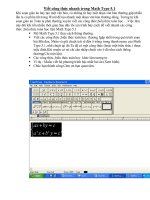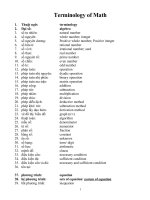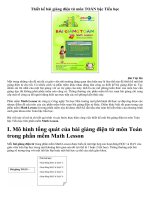- Trang chủ >>
- Mầm non >>
- Mẫu giáo lớn
Action math patterns
Bạn đang xem bản rút gọn của tài liệu. Xem và tải ngay bản đầy đủ của tài liệu tại đây (2.4 MB, 34 trang )
Action Math Patterns
Electronic book published by ipicturebooks.com
24 W. 25th St.
New York, NY 10011
For more ebooks, visit us at:
All rights reserved.
Copyright © 2000, 1994 Two-Can Publishing
No part of this book may be reproduced or transmitted
in any form or by any means, electronic or mechanical,
including photocopying, recording, or by any
information storage and retrieval system, without
permission in writing from the publisher.
e-ISBN1-59019-542-X
Library of Congress Cataloging-in-Publication Data is available
ACTION MATH
Ivan Bulloch
Consultants
Wendy and David Clemson
2
4
6
10
12
16
18
20
22
24
26
28
30
32
Looking at Patterns
Spiral Snake
Beads
Cake Fun
Weaving
Dot Patterns
Cut Paper
Tiles
Mosaics
Wrapping Paper
Mirror Prints
Fun Clothes
Stationery
Skills Index
2 Looking at Patterns
There are patterns all around us.
You can nd them in sidewalks, in
the stitches of your sweater, and on
a buttery’s wings. A pattern is made
when shapes or numbers are put in a
sequence and repeated. Look around
you. How many different patterns can
you see?
We use patterns to help us make sense
of the world. Math is all about patterns.
The activities in this book will help you:
sort things into groups.
match similar things.
nd out how things t together.
create patterns, shapes, and designs.
4 Spiral Snake
Make a patterned snake to hang from
your ceiling.
Painting a Spiral
Draw a spiral on
a piece of poster board.
Start from the edge of the
board and gradually spiral in
toward the center. You may
need to draw a few spirals
for practice rst.
Cut out the snake starting
from the end of the spiral on
the edge of the poster board.
Paint a snake pattern on
your spiral, or decorate it
with colored paper.
Ask an adult to string a
piece of thread through the
middle of the spiral. Now
hang up your snake.
Here’s what you learn:
how to create repeating
patterns.
how to change a at shape
into a three-dimensional one.
6 Beads
Threading beads is a good
way to make a pattern. Look
around your house or school
for things to use as beads.
Here are some ideas for
making your own beads.
Paper Beads
Glue together two pieces
of colored paper. Tear out a
triangle shape. Roll the shape
around a pencil and tape
down the narrow end.
Make a simple paper bead
with a long strip of colored
paper. Roll it around a pencil,
then tape down the end.
You could decorate the paper
before making your beads.
Pasta Beads
Pick pasta shapes with holes
through the middle.
Paint the shapes and let them dry.
Clay Beads
Use the type of modeling clay that
dries overnight to make these beads.
Make small balls of clay and ask an
adult to make a hole in each with a
knitting needle or toothpick. Let the
beads harden.
Sort Them Out
How many different types of beads
have you made or collected?
Sort the beads into different colors
and shapes.
Here’s what you learn:
how to sort things into different groups
or categories.
how to match similar things.
Beads to Find
If you look, you should be able to nd
lots of things to use as beads. We
used straws, plastic beads, and even
peanuts. Can you think of anything
else you could use?
Threading Beads
Now you can make some patterns with
your beads.
Use string or shoelaces to thread the
beads into a necklace.
Pick two kinds of beads. Thread
one kind, then another, onto the string.
Look at the patterns on this page,
then make up your own bead patterns.
pasta beads
paper beads
plastic beads
clay beads
paper beads
paper and wooden beads
peanut and
straw beads
10 Cake Fun
Here’s a delicious way to
play with patterns! Ask an
adult to help frost the top of
a cake with icing. Then use
different candies to
decorate the top.
Shapes and Colors
First decide which sweets
you are going to use.
Which shapes and colors
look good together? Which
are your favorites?
Planning your Pattern
Start by making a circle of
different candies around the edge
of the cake.
Choose another pattern for the
center of the cake. You could
make more circles or use different
candies to make a cross.
Here’s what you learn:
how to sort things into groups.
how to match similar things.
how to create simple patterns.
12 Weaving
Some clothes are made from woven
fabrics. The threads make a pattern.
These fabrics are made on large
machines called looms. You can do
your own weaving at home using a
cardboard loom and brightly colored
yarn or strips of felt.
Loom
Ask a grown-up to cut notches in two
ends of a small piece of cardboard.
Wind a piece of yarn around the
cardboard. The notches will keep it in
place. Tie the ends of the yarn at the
back.
Over and under
Thread a large, blunt needle with a
piece of yarn.
Push the needle under and over the
threads until you reach the other side.
Weave back the other way, under
the threads you went over before, and
over those you went under.
Cut the threads at the back to take
your weaving off. Tie the ends together.
Here’s what you learn:
how to create simple patterns.
how to use ideas about symmetry.
You can make a pattern with woven
paper, too! First, nd some fairly stiff
colored paper.
Simple Pattern
Fold a piece of paper in half.
Make a row of cuts along the folded
edge. Unfold the paper.
Cut some strips of another color.
Weave these strips through the slits
as shown at right.
Diagonal Strips
Fold another piece of paper
diagonally and make cuts. Weave
strips as shown below or below right.
Does the pattern look like the simple
pattern?
Here’s what you learn:
how to create patterns and shapes.
Wavy Strips
Cut wavy slits in a piece of paper.
You will also need some wavy strips
of another color. Weave the strips
as before.
Tartan Stripes
Cut two slits close together in a piece
of folded paper. Leave a gap, then cut
two more slits close together, and so
on. Weave thick and thin strips of
colored paper in and out of the slits.
Zig-zag Stripes
Ask an adult to make zig-zag slits in
the paper with a craft knife. Weave
straight strips through the slits.
16 Dot Patterns
Here’s another way to make patterns
with yarn.
Glue Patterns
Make a pattern with a few dots of
glue on a piece of poster board.
Take a piece of yarn. Press one end
into the glue.
Guide the yarn around the glue
pattern, pressing it down as you go.
Make a few different
patterns.
Pin patterns
Arrange a pattern of pins
on a piece of strong cardboard.
Take a piece of yarn and
tie it carefully to one of the
outside pins.
Stretch the yarn around
the pins, twisting it to keep
it in place. When you reach
the edge, tie the end of the
yarn and cut off any extra.
Here’s what you learn:
how to create dot
patterns.
how to create shapes.
18 Cut Paper
You can make some amazing patterns
by folding and cutting paper.
Fold and Cut
Fold a piece of paper in half and
then in half again. Cut a small piece
out of one edge. Unfold the paper.
To make a more complicated
pattern, make several cuts along the
edges before unfolding the paper.
Accordion Folds
Cut a long strip of paper.
Fold it backward and forward,
so the strip is like an accordion.
Ask an adult to help cut shapes out
of the folded paper.
Unfolded it to see your pattern.
Here’s what you learn:
how to create patterns.
how to discover symmetrical patterns.
20 Tiles
Each of these tiles has a very simple
design, but you can arrange them to
make all kinds of patterns.
Designing the Tiles
Cut out some squares of cardboard,
all the same size.
Choose a simple design and paint
all the squares exactly the same.
Arranging the Tiles
Start by arranging four tiles,
then add some more. How many
different patterns can you make
with your tiles?
Make three rows with all the
tiles facing the same way.
Make one row of tiles facing
one way, then the next row
facing the other way.
Here’s what you learn:
how to create shapes.
how to create patterns.
22 Mosaics
These colored shapes t together to
make patterns.
Making the Shapes
Cut some shapes from colored paper
or poster board. You could copy the
shapes shown on this page.
Fitting Together
Sort out the shapes. Put all the
triangles together, all the diamonds,
and so on.
See how the shapes that are the
same t together. Use different colors
to make a pattern.
Now try tting two different shapes
together. Which shapes t well?
Here’s what you learn:
how to create patterns.
how to t shapes together.









